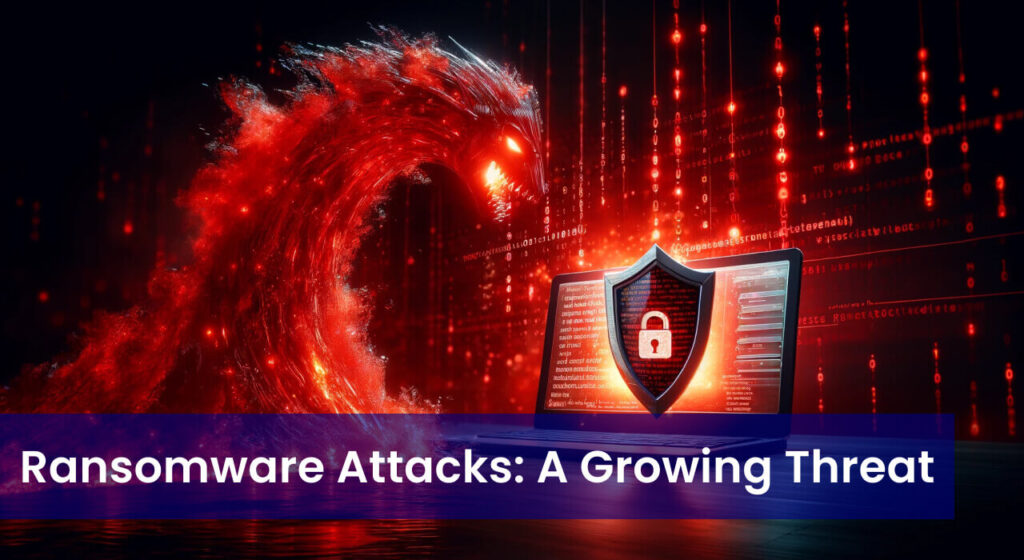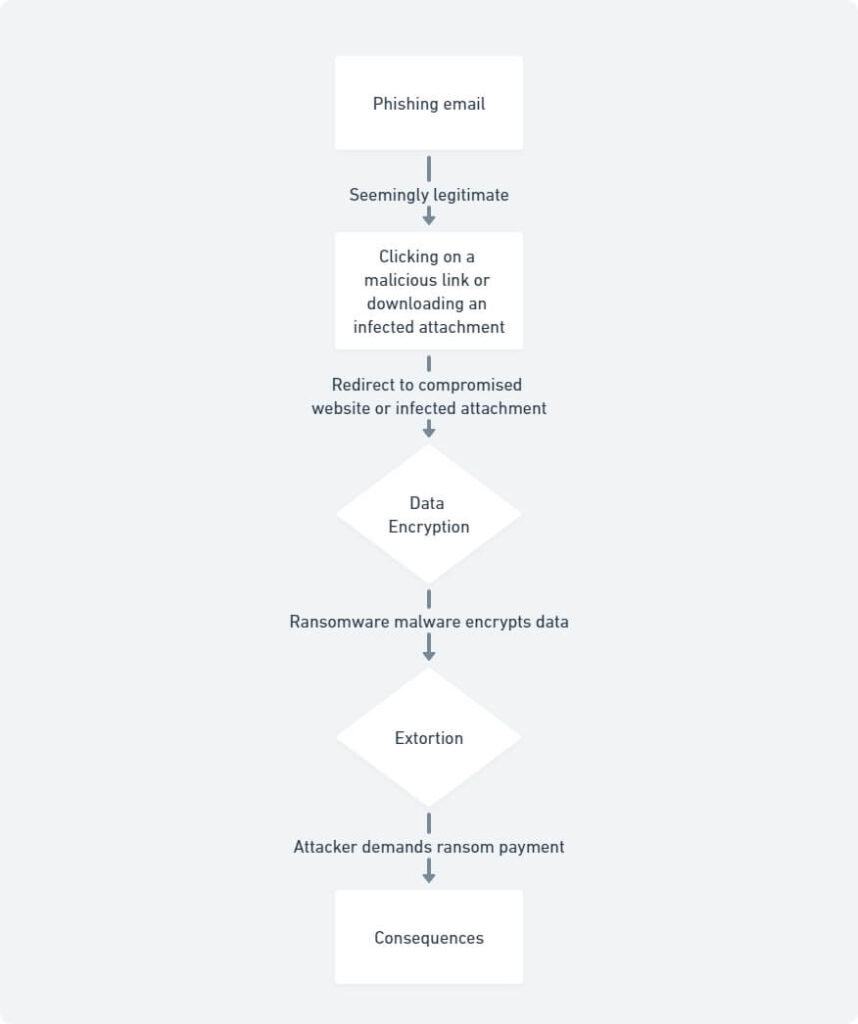
The Ransomware Threat - A Looming Shadow for SMBs
In the intricate web of today’s interconnected business landscape, a chilling threat lurks: ransomware. This malevolent software functions akin to a digital abductor, encrypting vital data and detaining it until a ransom is tendered.The consequences for businesses, particularly smaller ones, can be devastating.
A recent report by the Cybersecurity & Infrastructure Security Agency (CISA) found that ransomware attacks have increased by a staggering 300% in the past year alone. Small businesses, often perceived as easier targets due to potentially weaker cybersecurity defenses, are disproportionately affected. According to a study by Verizon, a whopping 43% of all ransomware victims are small businesses. These attacks can cripple a company’s operations, leading to lost revenue, compromised customer data, and a tarnished reputation. The financial toll is significant as well, with the average ransom demand exceeding $200,000 in 2023.
The good news is that businesses don’t have to be passive victims. By implementing robust cybersecurity measures, including comprehensive security assessments, companies can significantly reduce their vulnerability to ransomware attacks and safeguard their critical data. This article will delve into the growing threat of ransomware, explore its impact on small businesses and equip you with the knowledge and strategies to build a strong cybersecurity defense.
Ransomware's Relentless Onslaught

Ransomware attacks are no longer a looming threat; they are a constant and concerning reality for businesses of all sizes. A 2023 report by Veeam [https://www.veeam.com/blog/small-business-ransomware.html] paints a grim picture, revealing an alarming 85% increase in attacks targeting small businesses specifically. This surge in malicious activity is fueled by the growing sophistication of cybercriminals and the ever-expanding digital footprint of businesses.
The financial repercussions of a successful ransomware attack can be crippling. A study by the University of Maryland [https://www.law.umaryland.edu/content/articles/name-659577-en.html] estimates the average total cost of a ransomware attack to be a staggering $4.6 million, encompassing not only the ransom payment itself but also the associated downtime, data recovery efforts, and reputational damage. Beyond the immediate financial losses, operational disruptions caused by these attacks can have a long-lasting negative impact on a small business’s ability to function and serve its customers.
While the technical details of various ransomware strains can be intricate, the core objective remains the same: to render a victim’s data inaccessible. This can be achieved through encryption, where the attackers scramble the data using complex algorithms, or through data-wiping, where the information is permanently deleted. The choice of method often depends on the attacker’s goals and the type of data they target.
The growing prevalence of ransomware attacks underscores the critical need for small businesses to prioritize cybersecurity measures. By implementing robust defenses and cultivating a culture of cyber awareness, businesses can significantly reduce their vulnerability and protect themselves from this pervasive threat.
How Ransomware Attacks Small Businesses

Cybercriminals exploit various avenues to infiltrate a small business’s network and deploy ransomware. One of the most prevalent tactics involves phishing emails. These emails are carefully constructed to present an appearance of authenticity, frequently imitating reputable entities such as financial institutions, courier services, or even professional acquaintances.Unaware employees may be tricked into clicking malicious links embedded within the email or downloading infected attachments, unwittingly granting the attacker access to the system.
Another common approach involves malicious attachments. These attachments, disguised as harmless documents or software updates, harbor the ransomware payload. Once opened, the malware is unleashed, silently encrypting the victim’s data in the background.
Unpatched software vulnerabilities also provide a gateway for ransomware attacks. Outdated software often contains security holes that cybercriminals can exploit to gain unauthorized access to a system. This emphasizes the importance of regular security gap analyses to identify and address vulnerabilities before they can be weaponized.
Drive-by downloads pose another threat. These occur when a user unknowingly visits a compromised website that automatically triggers the download of malware onto their device. While not as common as other methods, drive-by downloads can be particularly dangerous as they can infect a system without any user interaction.
The human element is often the weakest link in a small business’s cybersecurity defenses. Employees who lack awareness of phishing tactics or who fail to maintain strong password hygiene become unwitting accomplices to cybercriminals. Regular employee awareness training is crucial to equip staff with the knowledge and skills to identify and avoid these digital pitfalls.

The Impact of Ransomware on Small Businesses

The consequences of a successful ransomware attack on a small business extend far beyond the initial shock. The financial impact is often devastating, encompassing a multitude of losses. The ransom payment itself can be a significant financial burden, with the average demand exceeding $200,000 in 2023.
However, the financial fallout doesn’t stop there. Downtime caused by the attack can cripple a small business’s ability to operate, leading to lost revenue and productivity. The data recovery process is also costly, requiring specialized expertise and time.
Beyond the financial losses, ransomware attacks can inflict severe reputational damage. A data breach, particularly one involving customer information, can erode trust and loyalty among clients. The negative publicity surrounding such an attack can have a long-lasting impact on a small business’s brand image and customer acquisition efforts.
The operational disruptions caused by ransomware attacks can be equally detrimental. With critical data locked away and systems compromised, core business functions can grind to a halt. This disrupts workflows, hinders communication, and can lead to delays in fulfilling customer orders or providing essential services. In the competitive landscape of today’s marketplace, such disruptions can significantly impact a small business’s ability to function effectively.
The multifaceted impact of ransomware underscores the critical need for small businesses to prioritize cybersecurity measures. By implementing robust defenses and cultivating a culture of cyber awareness, businesses can significantly mitigate the risk of a ransomware attack and safeguard themselves from this multifaceted threat.
Building a Cybersecurity Strategy

In today’s digital age, where cyber threats like ransomware are ever-present, a robust cybersecurity strategy is no longer a luxury; it’s a necessity for small businesses. This comprehensive plan acts as a shield, proactively safeguarding your organization’s data and systems from malicious attacks. By implementing a well-defined strategy, you can significantly reduce the risk of falling victim to ransomware and ensure business continuity in the face of potential threats.
Here are the key elements of a strong cybersecurity strategy for small businesses:
1. Security Awareness Training
Employees are often the first line of defense against cyberattacks. Regular security awareness training equips them with the knowledge and skills to identify phishing attempts, recognize suspicious emails, and avoid clicking on malicious links. This training should be ongoing and adapted to address the latest cyber threats.
2. Regular Security Assessments and Gap Analyses
Your network and systems are constantly evolving, and so are the vulnerabilities they may contain. Regular security assessments conducted by qualified professionals can help identify these vulnerabilities before they can be exploited by attackers. These assessments should be conducted periodically to ensure your defenses remain effective.
3. Strong Passwords and Access Controls
Simple passwords and lax access controls are open invitations for cybercriminals. Enforce strong password policies that require employees to use complex combinations of characters and symbols. Additionally, implement access controls that restrict user permissions based on their job function, ensuring only authorized personnel have access to sensitive data.
4. Regular Software Updates and Patching
Outdated software often contains security holes that attackers can leverage. Promptly installing software updates and patches is crucial to address these vulnerabilities and keep your systems protected. Consider automating the patching process whenever possible to ensure timely updates.
5. Data Backups and Recovery Plan
In the unfortunate event of a ransomware attack, having a robust data backup and recovery plan can be the difference between business disruption and swift recovery. Regularly back up your critical data to a secure offsite location and develop a documented recovery plan that outlines the steps to be taken in case of an attack. This plan should include procedures for restoring data, resuming operations, and minimizing downtime.
| Element | Description |
|---|---|
| Security Awareness Training | Equip employees to identify and avoid cyber threats. |
| Regular Security Assessments | Identify vulnerabilities in systems and networks. |
| Strong Passwords and Access Controls | Limit unauthorized access to sensitive data. |
| Regular Software Updates and Patching | Address vulnerabilities in software to prevent exploitation. |
| Data Backups and Recovery Plan | Ensure quick restoration of data in case of an attack. |
By incorporating these key elements into your cybersecurity strategy, you can significantly strengthen your defenses against ransomware attacks and protect your business from the financial and operational consequences they can inflict. Bear in mind that cybersecurity constitutes an enduring endeavor, necessitating perpetual vigilance and adaptability to preemptively address advancing threats.
Additional Resources and Support
Navigating the complexities of cybersecurity can be daunting for small businesses. Fortunately, there are valuable resources available to help you fortify your defenses. Many government agencies and industry organizations offer a wealth of free cybersecurity resources, including guides, checklists, and best practices specifically tailored to small businesses. You can also leverage the expertise of cybersecurity consulting firms that can provide comprehensive assessments, customised security solutions, and ongoing support to safeguard your business from evolving cyber threats.
Further Reading: Cybersecurity and Business Continuity
Looking to dive deeper into the realm of cybersecurity and fortify your business against digital threats? Explore our comprehensive guide on “Cybersecurity and Business Continuity: Ensuring Your Business Can Recover from an Attack.” This insightful piece delves into the critical importance of business continuity planning and offers practical strategies to safeguard your business operations.
Proactive Defense in a Digital Landscape
Navigating the complexities of cybersecurity can be daunting for small businesses. Fortunately, there are valuable resources available to help you fortify your defenses. Many government agencies and industry organizations offer a wealth of free cybersecurity resources, including guides, checklists, and best practices specifically tailored to small businesses. You can also leverage the expertise of cybersecurity consulting firms who can provide comprehensive assessments, customized security solutions, and ongoing support to safeguard your business from evolving cyber threats.
Categorized in:
Comments